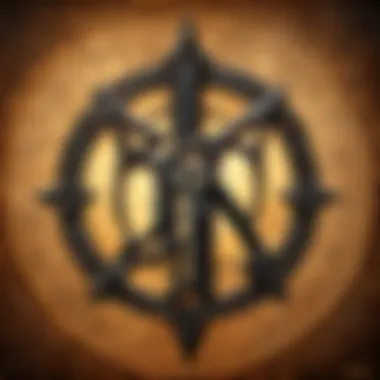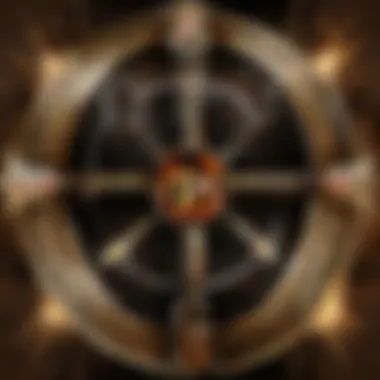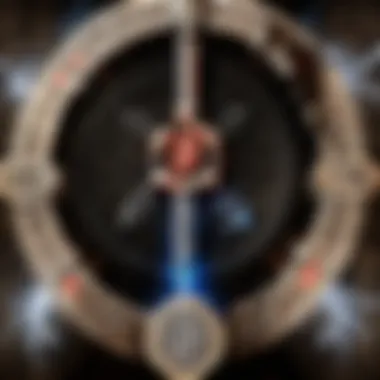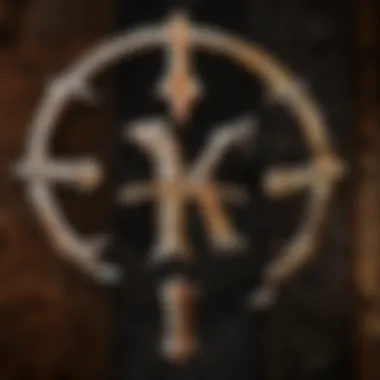A Comprehensive Exploration of High Runes in Diablo 2


Intro
Diablo 2, a classic action role-playing game, has garnered a dedicated fanbase since its release. A key component of its enduring appeal is the depth of its collectible items, particularly high runes. High runes not only influence gameplay mechanics but also play a crucial role in trading within the game. Understanding high runes, their types, and their utility can significantly enhance a player's strategic approach and enjoyment of the game.
High runes can be defined as some of the most valuable items within Diablo 2. They can be used in crafting powerful runewords, which can greatly amplify a character's abilities. In this article, we aim to provide a thorough examination of high runes, including their types, acquisition methods, and the economic implications surrounding them.
As players navigate through the complex world of Diablo 2, they encounter various strategies for utilizing these high-level runes effectively. This guide will not only focus on individual gameplay tactics but also the broader community and economic factors that influence player behavior. Going through this exploration will equip players with knowledge that can ultimately improve not just their gameplay but also their engagement with the entire Diablo 2 marketplace.
Understanding High Runes
High runes hold a pivotal role in the context of Diablo 2, serving as some of the most coveted and powerful items within the game. They are integral not just for enhancing character builds but also for crafting potent runewords that can drastically improve gameplay. A deep understanding of high runes aids players in effectively using them to optimize their characters or their trading strategies.
Players encounter high runes throughout their journey in the game, whether through drops, trading, or crafting. Therefore, knowing how to identify, acquire, and optimize these runes is vital for anyone aiming for success in Diablo 2.
Definition of High Runes
High runes are rare items classified as the most powerful runes in Diablo 2. Generally, any rune from Um Rune upward—such as Ber, Jah, and Zod—falls into this category. High runes are distinguished by their unique properties and substantial power increases they provide to items when used in runeword combinations. They are instrumental in elevating a character's capabilities and tailoring play styles effectively.
The value of high runes is also a significant factor. Each high rune possesses a specific market value determined by its rarity and usefulness in the game. Players often seek these items for their ability to unlock unique abilities and enhancements, showcasing their importance in gameplay.
Historical Context in Diablo
The history of high runes in Diablo 2 is a reflection of the game's evolution since its launch. Initially, runes were not as central to gameplay, but the introduction of runewords in Patch 1.10 shifted their significance. This was a pivotal moment that added depth and complexity to the game, encouraging players to explore rune combinations and tactics.
As Diablo 2 continued to grow in popularity, the demand for high runes increased. The community began to recognize their vital role in enhancing character builds and overall gameplay strategy. Over time, high runes have become a key element in player trading, with many unique gambling and farming strategies developing alongside their integration into the game's economy. This has shaped the current landscape of player interactions and trading practices, forging a rich history that continues to influence the Diablo 2 experience today.
"High runes are not just items; they are symbols of achievement and mastery in Diablo 2."
Types of High Runes
Understanding the types of high runes in Diablo 2 is critical for players who want to maximize their gameplay experience. High runes are not only valuable in crafting powerful runewords, but they also hold significant trade value in the community. Therefore, knowing the different rune categories and their specific attributes can help you make informed decisions during your gaming journey.
Overview of Rune Categories
High runes are generally categorized based on their power and the attributes they provide when used in runewords. They can be divided into three main categories:
- Common High Runes: These runes are widely sought after and are often used in popular runewords. Their utility makes them a staple in many character builds.
- Rare High Runes: These are less frequently found in gameplay. They often possess unique attributes that can enhance specific gameplay styles. Players often trade for these runes due to their scarcity and value.
- Legendary High Runes: This category includes runes that have become legendary due to their exceptional benefits. Items or runewords that utilize these runes typically enjoy increased demand in trading scenarios.
The significance of each category varies from a gameplay perspective, as certain runes may complement specific character builds or strategies.
Specific High Runes and Their Attributes
Ber Rune Overview
The Ber rune is known for its high damage output potential. It has become a preferred choice among players aiming for powerful melee builds. The key characteristic of Ber is its +20% Enhanced Damage. This feature makes it a highly beneficial rune in terms of maximizing your character's attack power. Additionally, Ber rune provides a 10% Damage Taken Goes to Mana, which aids resource sustainability during battles. However, obtaining a Ber rune can be challenging due to its rarity.
Tal Rune Overview


The Tal rune stands out in terms of versatility. It offers the +20% Faster Cast Rate, making it a popular choice for magic-based characters. This enhanced speed assists in delivering spells more efficiently, thus improving overall performance, especially in high-pressure situations. Tal also provides other useful attributes, like +10 to Energy and +25 to Life. While it may not offer the raw power of the Ber rune, Tal's advantageous qualities can make a significant difference in the right hands.
Zod Rune Overview
The Zod rune is particularly appealing due to its unique ability to render items indestructible. This characteristic alone is the reason many players seek it out, as it allows for greater longevity of equipment. The Zod rune also offers a +10 to Maximum Life, which can be essential for tank-heavy builds. However, its limited availability can make acquiring Zod challenging, leading to high trade values and demand within the community. As such, while it possesses unique advantages, the difficulty in obtaining it cannot be overlooked.
High runes in Diablo 2 represent not just powerful enhancements, but also an economic cornerstone of the game's community, influencing both gameplay and trade practices.
Mechanics of High Runes
Understanding the mechanics of high runes is crucial for any player striving to maximize their experience in Diablo 2. High runes serve not only as powerful items for character enhancement but also as critical components in crafting and runeword creation. The mechanics surrounding these runes determine their usability, value, and application within the game.
Crafting Runes
Crafting runes represents a strategic aspect of gameplay that can lead to significant enhancements in a player's arsenal. In Diablo 2, players can combine lower-tier runes with specific crafting recipes to produce new items or improve existing ones. The crafted items can vary widely in quality and effects, depending on the runes used and the combination process. Players often focus on specific high runes, as these have the potential to create powerful gear that can support various character builds.
When crafting, it is essential to consider the following:
- Rune Combinations: Each rune has unique properties. Understanding which runes complement each other can result in crafted items that magnify a player's strengths in combat.
- Recipe Variability: Different crafting recipes yield different outcomes. Experimentation with diverse combinations can reveal hidden potential within lesser-used runes.
- Gameplay Strategies: Players should integrate crafting into their regular gameplay loop. Regularly assessing crafted items can reveal opportunities for improvement, leading to a more efficient character build.
Runeword Creation Process
The process of creating runewords is one of the most engaging mechanics associated with high runes. Runewords are powerful items that players can create by inserting specific combinations of runes into socketed gear. The runes need to be placed in the correct order and in an appropriate item. The outcomes of such combinations can dramatically impact gameplay.
Key considerations in the runeword creation process include:
- Socketed Items: Only items that have socketed spaces can be used for runeword creation. Players should seek out armor, weapons, and shields that allow sufficient sockets to maximize their runeword options.
- Exact Rune Order: The order in which runes are socketed is critical. If the runes are not placed in the exact sequence needed, the desired runeword will not manifest. This attention to detail is paramount for players hoping to capitalize on the unique bonuses provided by high-runewords.
- Active Synergies: Different runewords offer various bonuses and effects. Selecting a runeword that synergizes with a player’s build boosts overall performance. For example, a runeword that increases spell damage can greatly benefit a mage character.
"The right combination of high runes can transform a character from average to extraordinary, making the mechanic of crafting and runeword creation essential parts of the Diablo 2 experience."
Acquisition Strategies for High Runes
Acquiring high runes in Diablo 2 is a fundamental aspect that can significantly affect a player’s overall experience and effectiveness in gameplay. These runes are not only valuable for their power-enhancing properties, but they also hold a high economic value in the game's marketplace. Understanding the strategies for obtaining these runes can lead to improved character builds and better trade opportunities, enhancing overall gameplay.
Finding High Runes in Gameplay
Finding high runes during gameplay involves several approaches. Players might engage in specific areas known for their rune drop rates. For instance, the Throne of Destruction and the Chaos Sanctuary are renowned for high rune drops. These zones are often classically farmed because of their high density of monsters and their potential to provide high-quality loot.
Moreover, participating in high-level player-versus-environment (PvE) content can increase the chances of rune drops. Engaging with higher levels of difficulty, such as Hell mode, tends to yield better results. Players can also utilize strategies like running specific bosses or areas repeatedly to maximize their chances of finding coveted high runes. Players should constantly gauge their drop rates and adapt accordingly.
Trading for High Runes
The trade system is another vital avenue for acquiring high runes. Trading offers a more dependable way to obtain specific runes, especially when gameplay drops are lacking. The community is often active in trading via forums or in-game. To navigate the trading landscape, players must be informed and strategic.
Current Trade Values
When discussing current trade values, it encapsulates the real-time marketplace for high runes. These values fluctuate based on player demand, supply levels, and overall economic trends within the game. Ber runes, for example, often command significant trade value due to their versatile use in powerful runewords. Tal runes might be less valuable but still hold importance for specific builds.
The key characteristic of current trade values lies in their volatility; prices can shift quickly. This characteristic makes it essential for traders to stay updated through online communities or trading platforms. Engaging with forums like Reddit or community pages can provide insights into the current market, allowing players to make informed decisions when trading.


Best Practices in Trading
Best practices in trading revolve around knowledge and communication. It is beneficial for players to research the values of different high runes to ensure they don’t overpay or under-trade. Using community boards can help in finding current prices and trading options.
Effective negotiation skills are also crucial. Clear communication ensures that both parties understand the value of what is being traded. Trust is established through honesty and willingness to facilitate smooth trades. Additionally, keeping a record of the trades can help players see what they have traded and their trading patterns over time. This will reinforce their trading strategy and improve their trading experience in the long run.
In summary, both finding and trading for high runes require a mix of strategic thinking and knowledge. The landscape of high runes in Diablo 2 is complex, but mastering these acquisition strategies greatly enhances a player's gaming experience.
Gameplay Impact of High Runes
The impact of high runes in Diablo 2 cannot be overstated. They play a vital role in enhancing player experience and strategy within the game. High runes are more than just collectible items; they significantly influence character builds and overall gameplay dynamics. Understanding their effects is crucial for players who wish to optimize their performance and navigate the challenges posed by the game.
Enhancing Character Builds
High runes can greatly enhance character builds. They provide unique bonuses and slots in runewords, allowing players to tailor their skills to match their preferred play style. For instance, a player utilizing the Enigma runeword gains teleport abilities, which can drastically improve speed and mobility in both PvE and PvP scenarios. The versatility of high runes allows for creative character customization.
- Key Enhancements
- Increased Damage Output: Runes like Ber offer significant damage boosts.
- Enhanced Defensive Capabilities: Using runes such as Mal can result in better survivability.
- Utility and Mobility: The ability to teleport or gain faster run speed can change the pacing of gameplay.
Players are encouraged to experiment with various combinations of high runes to discover synergies that suit their objectives. This experimentation fosters a deeper engagement with the game and enhances the overall playability, leading to diverse character scenarios.
Impact on Game Difficulty
High runes also impact game difficulty, altering the balance between challenge and player capability. As players integrate high runes into their gear, they can transition more effectively through the game's tougher levels, including Hell mode. The increased strength from high runes can make certain encounters feel significantly smoother, which might undermine the intended challenge for some players.
This raises an important discussion in the community about the pacing and balancing of the game. While high runes can facilitate progression, they can also lead to lower stakes in challenging situations, altering the player experience. Consider the following:
- Game Difficulty Adjustments:
- Easier Progression: Characters can defeat bosses efficiently with powerful runewords.
- Potential Overreliance: Players might find themselves depending heavily on items rather than skill or strategy.
- Community Feedback: Discussions on platforms like Reddit show mixed feelings about high runes potentially diminishing true challenge.
High runes enrich gameplay but must be used wisely to preserve the intended challenge in Diablo 2.
Economic Aspects of High Runes
The economic aspects of high runes in Diablo 2 represent a crucial element in understanding the broader implications of gameplay within the game. High runes are not merely items for crafting and enhancing character builds; they also serve as commodities that are subject to market forces, player demand, and community value. This section aims to illustrate how high runes interact with the economy of Diablo 2 and the significance of these interactions for players.
Market Trends for High Runes
Tracking market trends for high runes provides insights into the dynamic nature of the Diablo 2 economy. The value of high runes fluctuates based on various factors, including:
- Game Updates: Patches can alter gameplay mechanics or introduce new runewords, affecting the desirability of certain runes.
- Community Events: Special events or seasons may increase demand for specific high runes due to changes in gameplay or challenges.
- Scarcity: How often certain high runes drop can create a sense of scarcity, thereby boosting their market value.
Currently, some high runes, such as the Ber Rune, tend to hold stable value because they are essential for popular runewords. In contrast, others might experience volatility based on patch notes or community discussions on platforms like reddit.com.
One observes spikes in value that correspond directly to community interest and awareness. For example, players flying under the radar might stockpile specific high runes in anticipation of a market rise. Emergent patterns in trading habits highlight the importance of staying informed and adaptable.


Influence of High Runes on In-Game Economy
High runes exert a significant influence on the in-game economy of Diablo 2. They serve as key items for trade, affecting both player interactions and resource allocation. Their value creates opportunities for strategic gameplay and investment.
- Bartering Power: Players often utilize high runes as the baseline currency for bartering, leading to rich exchanges that can significantly impact a player's inventory and progression.
- Accessibility vs. Rarity: High runes refine gameplay experiences, balancing the accessibility of gameplay as they encourage players to form connections through trade. However, they also embody a form of elitism that can lead to disparities in player experience.
- Investment Strategies: Smart players often stockpile high runes with the intent of trading them at peak value. Their market deflation can adversely affect these players if a sudden influx of high runes occurs.
"High runes are not just tools for improvement; they are central to the economic fabric of Diablo 2."
In summary, high runes provide more than gameplay enhancements; they encapsulate an intricate economic structure that influences player interactions and market dynamics. Understanding these trends can elucidate how high runes shape the unique environment of Diablo 2.
Community Perspectives on High Runes
Community perspectives on high runes in Diablo 2 reveal not just the hype surrounding these items but also their evolution within player interactions. Understanding these perspectives sheds light on the social fabric of the game, exhibiting how players connect, share, and strategize around high runes. This section helps illuminate the communal dynamics that affect rune value, trading tactics, and player experiences.
Player Experiences
Player experiences with high runes greatly vary. Some players hunt for specific runes, developing unique strategies to secure their targets. The process often includes participation in community events or trading opportunities where runes are commonly exchanged. Many players share stories of success, where the discovery of a high rune led to significant character enhancements or valuable trade deals.
However, the experiences are not only positive. Some players report frustration, particularly when desired runes seem elusive. This shared struggle often leads to a deeper appreciation for the runes they eventually obtain. Players often share their best tactics for finding high runes, including preferred locations, monster types, and specific game modes.
The narratives around these experiences contribute to a larger community mythos, adding layers to the significance of high runes. Players learn from each other, benefiting from collective knowledge about what works in terms of rune acquisition and use. Discussions about personal encounters underscore a sense of camaraderie, as players empathize with each other's journeys in the game.
Community Forums and Discussions
Community forums serve as a hub for discussions about high runes. Websites like Reddit are bustling with threads that focus on all nuances of rune usage. Players post their thoughts on trade values, desirable runes, and insights into the best build combinations. The collective insight found in these forums provides clarity on complex trading dynamics.
Important topics often include:
- Current trends in rune trading
- Suggestions for effective builds using specific high runes
- Player reviews of specific runeword combinations
These forums also act as platforms for critique, where players can voice their opinions about balancing and changes within the game, particularly as it applies to high runes. Feedback often influences player perceptions and can cause shifts in community behavior concerning rune value and importance.
Additionally, community events often arise from discussions on these platforms. These activities foster interaction and enhance engagement. It becomes evident that community feedback not only educates players but also shapes the player-driven economy surrounding high runes.
"High runes are not just items; they tell stories of patience, effort, and sometimes, sheer luck."
In summary, examining community perspectives on high runes unveils a layered understanding of their significance. Players not only engage with these items on a technical level but also form an emotional connection rooted in shared experiences. Such perspectives enrich the ongoing dialogue, ensuring high runes remain an integral part of Diablo 2's community dynamic.
Future of High Runes in Diablo
The future of high runes in Diablo 2 is an intriguing topic that warrants significant attention. As the game continues to evolve, so too do the mechanics surrounding high runes. Understanding how potential updates could impact runes allows players to adapt their strategies effectively. Players benefit from staying informed about possible changes in the game's landscape. These adjustments can enhance gameplay, shifting the balance of power in character builds and influencing the in-game economy.
Potential Game Updates and Changes
Game updates play a crucial role in shaping the relevance of high runes. Blizzard has a history of refining gameplay mechanics based on player feedback. This may include introducing new runes, modifying existing runewords, or altering drop rates. Such changes can redefine how players interact with high runes. New runes may introduce unique attributes, giving players innovative strategies to explore. Additionally, existing runewords might see updates, leading to altered characteristics that can significantly shift the meta.
- Increased Availability: Future updates could increase the drop rates of high runes, making them more accessible to players.
- New Gameplay Mechanics: Introducing runes with unique effects may promote diverse gameplay styles.
- Revised Trade Dynamics: Changes in rune drop rates or strengths may affect trade values and strategies among players.
Implications for Future Gameplay
The implications for future gameplay concerning high runes are multifaceted. For players, understanding potential changes helps them stay competitive. Players may need to rethink their build strategies and adjust their priorities based on new rune attributes or availability.
- Adaptation in Builds: With each update, new optimal builds may emerge, challenging players to explore previously unutilized runes.
- Market Shifts: Adjustments in rune value will demand a keen understanding of the market for successful trades.
- Community Engagement: Updates may inspire discussions within the community, fostering collaboration in developing new strategies.
The changes and updates in high runes can extend the game’s longevity, keeping the community engaged and active.



